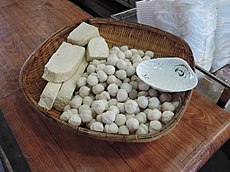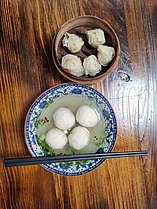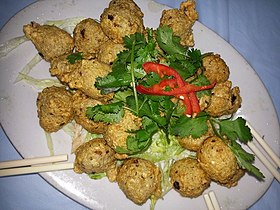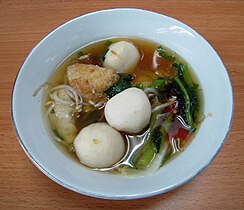Fish ball
This article possibly contains original research. (September 2021) |
| Fish ball | |||
|---|---|---|---|
 Fish balls | |||
| Traditional Chinese | 魚丸 | ||
| Simplified Chinese | 鱼丸 | ||
| Literal meaning | fish ball | ||
| |||
| Alternative Chinese name | |||
| Traditional Chinese | 魚蛋 or 魚旦 | ||
| Simplified Chinese | 鱼蛋 or 鱼旦 | ||
| Literal meaning | fish egg | ||
| |||
Fish balls are rounded meat balls made from fish paste which are then boiled or deep fried. Similar in composition to fishcake, fish balls are often made from surimi, salt, and a culinary binder such as tapioca flour, corn, or potato starch.[1]
Fish balls are popular in East Asia, eaten as a snack or added to soups or hotpot dishes. In South East Asia, they are usually attributed to Chinese cuisine and the fish ball industry is largely operated by people of Chinese descent.[2]: 286 Nordic countries also have their own variation.
Production[]
There are two variants of fish balls, each differing in its textures, production method, and primary regions of production:
- For East Asian fish balls, the fish are shredded, coarsely ground, or even pounded. The fish then undergoes prolonged mixing with added salt and crushed ice until a smooth texture is attained. Other ingredients are added, such as sugar, monosodium glutamate, or flour, and then water is added to ensure the ball has a "soft, springy texture." This technique, similar to the process of making surimi, uncoils and stretches previously wound and tangled protein strands in the fish, which produces food with a firm "bouncy" texture. In commercial production, the balls are shaped by an extruding machine, and set in water between 30 and 45C before boiling, cooling, then packaging.[2]: 287
- Scandinavian fish balls are made of completely pureed fish, milk, and potato flour (or potato starch), and they are shaped without additional processing, which produces a softer textured food.
Regional variations[]
This section needs additional citations for verification. (January 2019) |

East Asia[]
Fuzhou[]
In the Fuzhou area, "Fuzhou fish balls" (福州鱼丸) are made from fish with a minced pork filling. The variation from Fuqing is much larger.
Hong Kong and Macau[]
Fish balls are one of Hong Kong's most popular and representative "street foods", eaten plain or cooked in a curry sauce.[3][4] The 2016 Mong Kok civil unrest, which escalated from the government's crackdown on unlicensed street hawkers during the Chinese New Year holidays, has been referred to by some media outlets and social media platforms as the "Fishball Revolution" (魚蛋革命).
Readily available in traditional markets and supermarkets, fish balls are also a popular ingredient in hot pot.

There are three kinds of fishballs, known as 魚蛋 (literally "fish eggs"), sold in Hong Kong and Macau. They are yellow, white, and golden.
White fish balls are larger in size and made with white fish, such as Spanish mackerel, pounded many times until the fish is a fine paste. Salt can be added, or egg whites and corn starch, but generally no other ingredients are added. The balls are then cooked by boiling. White fish balls should have an elastic (bouncy) and fluffy texture and a strong taste of fish. They are made using a more costly fish, and they have a considerably different texture and taste. This kind is usually served to complement noodles at Cháozhōu-style noodle restaurants,[5] and at some cha chaan tengs, which also sell beef balls (牛丸) and cuttlefish balls (墨魚丸).
White fish balls from traditional fish ball restaurants are made from fresh fish and are normally hand-made (手打) by the owners using traditional techniques.
The big golden fish ball is a snack in Cheung Chau. Distinguishing features include size, sauce and texture. They can be fist-sized and are served with a special curry sauce, and they are mainly made from fresh fish which makes the texture more smooth.
Ingredients[]
Flathead mullet (九棍魚/烏仔魚) and Daggertooth pike conger (門鱔) are common choices.
Originally, to reduce costs, they were likely made by mixing and frying the remaining materials of Chaozhou fish ball (潮州白魚丸) or stale fish. They began to be imported more recently, and nowadays, they are mainly imported by wholesalers and the texture is more consistent.[6]
Taiwan[]
Milkfish balls (虱目魚丸) are frequently found in Taiwan. The natural texture and aroma of the milkfish give this variant a unique taste. This is one of the main ways milkfishes' lesser-prized yet highly abundant white meat is consumed.
Fish balls with roe (魚包蛋) are served at hot pot restaurants. They have a sweet and salty taste with a popping element from the roe's texture. There is also a fried golden version.

Japanese fried fish balls
Fuzhou fish ball soup

Fuzhou fish ball soup from Lianjiang

Fuzhou Yu Wan fish balls

Hakka fish ball rice noodle soup

Hong Kong fish balls made from dace

A bowl of curry fish balls, pork rinds and radish sold in Hong Kong
Southeast Asia[]
Indonesia[]
In Indonesia, fish balls are called bakso ikan (fish bakso). The most popular bakso are made of beef, but fish bakso is also available, served with tofu, vegetables, and fish otak-otak in clear broth soup as tahu kok. Bakso ikan has softer texture and lighter color compared to beef balls. Bakso ikan may be thinly sliced as additional ingredients in mie goreng, kwetiau goreng, nasi goreng and cap cai. A similar dish made of fish surimi is called pempek; however, most of pempek are deep fried instead of boiled.
Malaysia and Singapore[]
In Singapore, fish balls are also known as known as 鱼圆 (yú yuán) or 魚丸 (yú wán). In Malaysia and Brunei, fish balls are called bebola ikan.
Traditionally, fish balls were made from locally sourced fish such as coral fish and Dorab. Production scale varies from individual hawker stalls to large corporate factories which supply the local and export markets. Due to higher labor costs and limited local fish supply, surimi is mostly sourced from Malaysia, India, Indonesia, and Thailand, and fishballs are produced at a lower cost by mixing surimi with fresh leached fish mince. Higher quality fish balls are made from wolf herring, coral fish, Spanish mackerel, and Conger eel. [2]: 286–287
Singapore consumes 10 kg. of fishballs per capita per year (as of 2002), possibly the world's largest consumer of fishballs.[2]: 286–287 They can be served with soup and noodles like the Chiuchow style or with yong tau foo (酿豆腐). They can also be served with noodles called mee pok. In some cases, it is also fried and served on a stick. Fish balls are the second most processed fish-based product in Malaysia, roughly 10% of the total produced.[2]: 287
Philippines[]
Fish balls are a popular street food in the Philippines and are considered a cultural delicacy. The most common type of Filipino fish balls are known as bola-bola. They are round in shape, most often made from cuttlefish or pollock, and served with a sweet and spicy sauce or with a thick, black sweet and sour sauce.
Fish balls in the Philippines are sold by street vendors pushing wooden deep-frying carts. The balls are served skewered, offered with three kinds of dipping sauces: spicy (white/orange coloured) – vinegar, water, diced onions and garlic; sweet (brown gravy coloured) – corn starch, banana ketchup, sugar and salt; and sweet/sour (amber or deeper orange coloured) – the sweet variety with many small hot chilis added. Dark sauces are rare, as these are soy sauce-based and soy sauce is expensive for street food.
A recent trend in the industry is the introduction of varieties: chicken, squid (cuttlefish actually), and elongated versions of fishballs inaccurately called kikiam. The latter, however, are completely different dishes from true kikiam (a Filipino version of Hokkien ngo hiang).[7][8]
Thailand[]
Fish balls are very popular in Thai cuisine. They are usually fried or grilled as a snack. In Chinese-influenced restaurants, fish balls are cooked in noodle soups and come in many varieties. They can also be eaten in a Thai curry. Kaeng khiao wan luk chin pla is green curry with fish balls. One of the main fishes used in the production of fish balls in Thailand is Pla krai (Chitala ornata).

Bakso ikan (fish balls) with tofu soup in Indonesia.
Deep-fried fish balls in a noodle soup from Kampar, Perak, Malaysia

Fried fish balls from the Philippines
Fish balls with vermicelli sold in Bukit Batok, Singapore

Thai Kaeng khiao wan luk chin pla, green curry with fish balls

Vietnamese bún riêu
Europe[]
Known as Fiskbullar in Sweden and fiskeboller in Norway and Denmark, Nordic fish balls are white and without breading, and usually come in metal cans or transparent plastic containers containing stock or brine.
Faroe Islands[]
In the Faroe Islands, fish balls are called knettir and are made with groundfish and mutton fat.
Norway[]
In Norway, fish balls (fiskeboller) are a staple food commonly served with potatoes, carrots and/or cauliflower or broccoli in a white sauce. The sauce is often made with the stock from the container, sometimes with mild Madras curry seasoning as a condiment, or mixed to create curry sauce. Adding ketchup to the sauce is commonplace among children.
Additionally, there is a pudding made with minced, groundfish and milk (fiskepudding) or, more luxuriously, with cream (fløtepudding), served with potatoes, carrots, steamed peas, and cauliflower, and sometimes shrimp. Tiny fish balls called suppeboller (literally "soup balls") are also common in fish soup.
Sweden[]
In Sweden, fiskbullar are normally served with mashed potatoes or rice, boiled green peas and dill, caviar or seafood sauces.
Iceland[]
There are two types of fishballs in Iceland with very similar names. Fiskbollur [ˈfɪskˌpɔllʏr̥] is very similar to those of Norway and Sweden,[9] whereas Fiskibollur [ˈfɪscɪˌpɔllʏr̥] are fried brown in a pan.[10] Both varieties are served with boiled potatoes, carrots, lettuce, and either bechamel or Madras curry sauce.
Germany[]
German fish balls, known locally as fischklößchen, rely heavily on herbs and herb sauces.
Italy[]
Italian fish balls, known locally as polpette di pesce, are fried with parmesan and breadcrumbs, and they are usually served with a tomato sauce. They can be found both as rounded balls and as patties.

Fiskbullar atop rotini pasta
Jewish fish balls in tomato sauce

German fischklößchen

Italian fish balls with crab and zucchini

Italian crab fish balls with quinoa

Jewish gefilte fish balls served during Rosh Hashanah
See also[]
- Fishcake
- Fish slice
- Jiaozi
- Quenelle

Wikimedia Commons has media related to Fish balls. References[]
- ^ Commodity Classifications Under the Harmonized System. Department of the Treasury, U.S. Customs Service. 1990. p. 194.
- ^ Jump up to: a b c d e Park, Jae W. (12 November 2013). Surimi and Surimi Seafood, Third Edition. CRC Press. ISBN 978-1-4398-9857-4.
- ^ "Where to go to eat Hong Kong's best fish balls". South China Morning Post. 29 January 2019. Retrieved 18 September 2021.
- ^ "The humble fishball: the iconic street food that is Hong Kong". South China Morning Post. 5 September 2020. Retrieved 18 September 2021.
- ^ Man, Joyce "Aberdeen's best fish ball shop to close" Archived 29 February 2012 at the Wayback Machine CNN Go. 24 February 2012. Retrieved 4 March 2012
- ^ 《50經典小吃》刊於2003/01/10《飲食男女》
- ^ "Fish Kikiam". Panlasang Pinoy Meaty Recipes. Retrieved 9 May 2019.
- ^ "Authentic Kikiam Recipe". Cooking Pinoy Recipes. Retrieved 9 May 2019.
- ^ "Ora Fiskibollur 1/2 dós". Retrieved 17 April 2021.
- ^ "Grímur Kokkur Fiskibollur 1 kg" (in Icelandic). Retrieved 17 April 2021.
- Fish dishes
- Fujian cuisine
- Hong Kong cuisine
- Icelandic cuisine
- Indonesian cuisine
- Malaysian cuisine
- Mauritian cuisine
- Meatballs
- Norwegian cuisine
- Philippine cuisine
- Singaporean cuisine
- Street food
- Surimi
- Swedish cuisine
- Taiwanese cuisine
- Thai cuisine
- Teochew cuisine




















